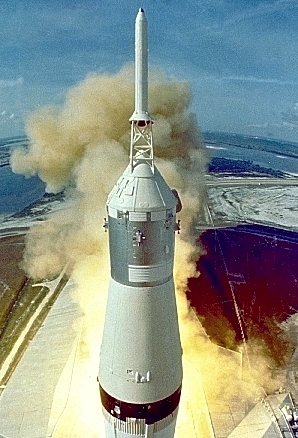
 |
![]() La mission Apollo 11 au décollage
La mission Apollo 11 au décollage
Le programme Apollo, qui permit aux Etats-Unis d'atteindre la Lune, fut annoncé le 25 mai 1961 par le président Kennedy: les Etats-Unis allaient, avant la fin de la décennie, faire atterrir des astronautes sur la Lune et les ramener sur Terre. Ce fut la mission Apollo 11 qui, en juillet 1969, réalisa la promesse. Neil Armstrong, le 20 juillet 1969, devint ainsi le premier homme à marcher sur la Lune. On voit ici la mission Apollo 11 au décollage, le 16 juillet. Les missions Apollo étaient propulsées par une fusée puissante, la Saturn V. Elle avait été conçue par Wernher von Braun. C'était une fusée de trois étages, d'une hauteur de 110 m (363 ft). Le programme Apollo se basait sur l'utilisation de différents modules, chacun ayant une fonction au long du voyage vers la Lune. Ici, au sommet de la Saturn V, surmonté de la fusée de secours, on voit l'ensemble module de commande/module de service qui comprend à la fois la capsule, de forme cônique, qui abrite les astronautes et le module cylindrique, qui est un compartiment technique, muni d'un moteur et fournissant les éléments vitaux (oxygène, etc) à l'équipage au cours du vol. Le "module lunaire" (ou "LEM"), au décollage, se trouvait au sommet du troisième étage de la fusée Saturn. Il en était ensuite, sur la trajectoire lunaire, extrait et arrimé aux deux autres modules. Une fois la mission arrivée à la Lune, deux des trois astronautes passaient dans le LEM et ils descendaient vers la Lune. Une fois leur séjour terminé, ils remontaient en orbite lunaire grâce à la partie supérieure du LEM et s'arrimaient de nouveau aux deux autres modules. Les missions Apollo mettaient trois jours pour atteindre la Lune et trois jours pour en revenir. La dernière mission Apollo fut la mission Apollo 17 en décembre 1972. Le programme Apollo fut sans doute l'épisode le plus spectaculaire de la conquête spatiale, laquelle commença en octobre 1957 lorsque l'ancienne Union Soviétique plaça avec succès le premier satellite artificiel terrestre, le célèbre "Spoutnik", en orbite. site 'Amateur Astronomy'